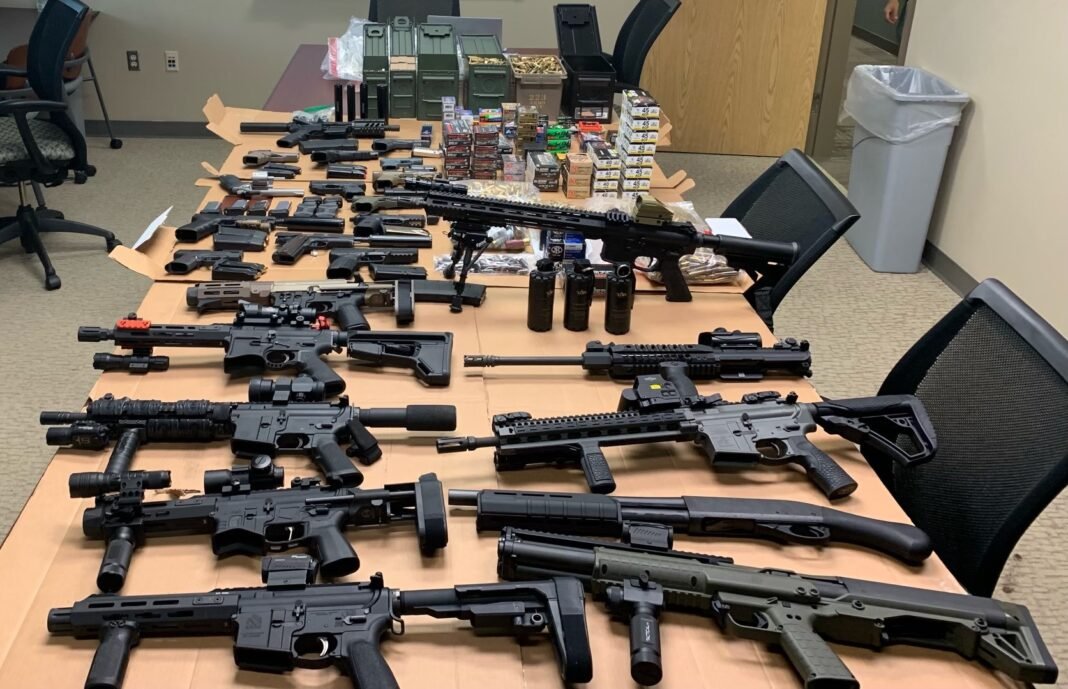A report by the Military Police Intelligence Subsecretariat reveals that only 34 of the 638 rifles seized by the Military Police in Rio de Janeiro in 2024 — just 5.32% — were manufactured in Brazil. The remaining 604 rifles are of foreign origin. The United States ranks first among the countries of origin, with 295 rifles of the Colt platform seized. Although American-made, these weapons are licensed for export, which facilitates their clandestine entry into Brazil through borders with Paraguay, Bolivia, and Colombia. The report also indicates that at least 25 of the seized rifles show signs of having entered the country disassembled, with individual parts purchased in the U.S.
This Content Is Only For Subscribers
To unlock this content, subscribe to INTERLIRA Reports.
Evidence of Assembly from Parts
One piece of evidence is the presence of a skull-shaped logo on ballistic components, a symbol used by an American factory known for selling rifle parts. In some cases, parts from airsoft guns — such as frames and stocks — are fused with leftover components from other firearms by local gunsmiths, resulting in new, functional rifles.
Costs and Value
A disassembled rifle of this kind costs about R$6,000 in the United States. Once assembled and sold in Rio, it can reach prices as high as R$50,000 when acquired by criminal factions or militias. Other foreign seized rifles were manufactured in countries such as Germany, Israel, Austria, and the Czech Republic. The combined estimated market value of the 638 rifles seized in 2024 is approximately R$44 million.
Territorial Control and Seizures
The document also provides data on the territorial control of the locations where seizures occurred. In areas controlled by the Red Command (CV), 365 rifles were seized. Another 204 were confiscated in areas controlled by the Third Pure Command (TCP). Militias lost 48 rifles, and the Friends of Friends (ADA) faction had 12 rifles seized. Seven seizures took place in areas not dominated by any faction, and two occurred in contested territories.
International Presentation
The report was produced under the leadership of Colonel PM Uirá Nascimento, Undersecretary of Intelligence, and was among the documents presented by Governor Cláudio Castro during a meeting with representatives of the United Nations Office for Disarmament Affairs in New York on 12 May. During the meeting, the governor proposed international cooperation to prevent arms trafficking and reduce the arrival of high-powered weapons in Rio.
The U.S. Connection
On 15 May, Extra Newspaper reported that a trafficking route connects the United States to Rio’s favelas, fueling armed conflicts with American-made weapons. According to the Military Police, 60% of all rifles seized in the state in 2025 originated in the U.S. Investigations show that these weapons primarily enter Brazil across the borders with Paraguay and Bolivia and are transported by road to Rio. Authorities report that traffickers now use dozens of intermediaries to discreetly build up their arsenals and avoid detection.
Joint Operation with the U.S.
This international supply chain has already drawn the attention of the U.S. government. During Operation Containment — which seized 240 firearms and over 43,000 rounds of ammunition in four Brazilian states on 13 May, including a stash found in a mansion in Barra da Tijuca — agents from Homeland Security Investigations (HSI), a division of the U.S. Department of Homeland Security (DHS), collaborated with Brazilian authorities. HSI focuses on investigating transnational crime and threats to U.S. security.
Analysis:
The data presented by the Military Police Intelligence Subsecretariat presents a troubling picture of the internationalization of armed violence in Rio de Janeiro. The fact that over 94% of the rifles seized in 2024 were of foreign origin, primarily from the United States, reveals a significant failure in border control and arms trafficking prevention. Criminal factions are not only well-equipped — they are strategically investing in assembling high-powered weapons through sophisticated smuggling and distribution networks that stretch across continents.
According to the Military Police Secretary, Colonel Marcelo Menezes, although rifle seizures reduce the firepower of criminal groups and militias, they do not fully resolve the problem. He acknowledges that preventing these weapons from entering Rio de Janeiro in the first place would be far more effective.
The widespread availability of military-grade firearms continues to deepen the firepower imbalance between criminal groups and law enforcement. This, combined with the territorial fragmentation caused by rival factions and militias, contributes to the dangerous militarization of urban spaces.




